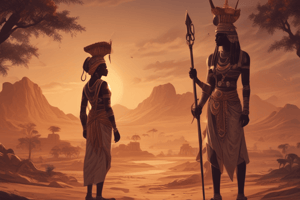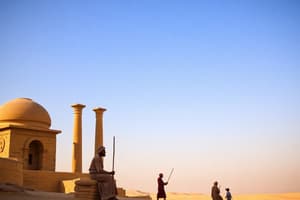Podcast
Questions and Answers
Who is thought to have unified Lower and Upper Egypt?
Who is thought to have unified Lower and Upper Egypt?
- Hor-Aha
- Narmer (correct)
- Menes
- Scorpion I
What significant artifact changed the understanding of the timeline of Egyptian unification?
What significant artifact changed the understanding of the timeline of Egyptian unification?
- The Rosetta Stone
- The Narmer Palette (correct)
- The Great Pyramid
- The Scorpion Macehead
What role did Egyptian kings hold during the Early Dynastic Period?
What role did Egyptian kings hold during the Early Dynastic Period?
- Religious leaders only
- Only political rulers
- Both god and king (correct)
- Merchants and traders
Which writing script was primarily reserved for religious purposes in ancient Egypt?
Which writing script was primarily reserved for religious purposes in ancient Egypt?
What was one significant aspect of women's roles in ancient Egypt compared to other ancient agrarian societies?
What was one significant aspect of women's roles in ancient Egypt compared to other ancient agrarian societies?
Which aspect of culture did the Egyptians emphasize as part of their worldview?
Which aspect of culture did the Egyptians emphasize as part of their worldview?
What might the similarities between the ancient scripts of Egypt and Nubia indicate?
What might the similarities between the ancient scripts of Egypt and Nubia indicate?
Which of the following statements is true regarding the Early Dynastic Period in Egyptian history?
Which of the following statements is true regarding the Early Dynastic Period in Egyptian history?
What indicates a connection between Nubian and early Egyptian societies?
What indicates a connection between Nubian and early Egyptian societies?
Which item found in Nubian graves indicates high social status?
Which item found in Nubian graves indicates high social status?
What is significant about the lapis lazuli found in Nubian artifacts?
What is significant about the lapis lazuli found in Nubian artifacts?
During which period did the first dynasties in Egypt begin to rule?
During which period did the first dynasties in Egypt begin to rule?
Which aspect reflects the importance of women in Nubian society?
Which aspect reflects the importance of women in Nubian society?
What was the role of the goddess Isis in both Nubian and Egyptian cultures?
What was the role of the goddess Isis in both Nubian and Egyptian cultures?
Which of the following best describes the trade activities of Nubia?
Which of the following best describes the trade activities of Nubia?
Why does the analysis of grave goods provide insight into Nubian culture?
Why does the analysis of grave goods provide insight into Nubian culture?
What was a primary factor encouraging the growth of settlements in Lower Egypt?
What was a primary factor encouraging the growth of settlements in Lower Egypt?
What process preceded the establishment of complex farming societies in Egypt?
What process preceded the establishment of complex farming societies in Egypt?
What agricultural method was important in the early Egyptian communities?
What agricultural method was important in the early Egyptian communities?
What was the main focus of the excavation efforts in Egypt for more than a century?
What was the main focus of the excavation efforts in Egypt for more than a century?
What does the shared practice of burial facing west indicate among Nubians and Egyptians?
What does the shared practice of burial facing west indicate among Nubians and Egyptians?
What major factor contributed to the shift from foraging to farming in ancient agrarian societies along the Nile River?
What major factor contributed to the shift from foraging to farming in ancient agrarian societies along the Nile River?
Which geographical feature was essential for the development of ancient agrarian societies like Egypt and Nubia?
Which geographical feature was essential for the development of ancient agrarian societies like Egypt and Nubia?
What characterized the A-Group culture of Nubia?
What characterized the A-Group culture of Nubia?
How did interactions between communities along the Nile River impact their development?
How did interactions between communities along the Nile River impact their development?
What was the primary reason for early humans choosing to settle near the Nile River?
What was the primary reason for early humans choosing to settle near the Nile River?
What evidence suggests that the transition from foraging to farming was gradual?
What evidence suggests that the transition from foraging to farming was gradual?
Which period marks the A-Group culture in Nubia?
Which period marks the A-Group culture in Nubia?
What kind of agricultural practices did people in rural areas of the Nile Valley most likely engage in?
What kind of agricultural practices did people in rural areas of the Nile Valley most likely engage in?
Flashcards
Agrarian Societies
Agrarian Societies
Societies that rely heavily on farming as their primary economic activity.
Ancient Egypt and Nubia
Ancient Egypt and Nubia
Ancient civilizations in the Nile River Valley, known for their advancements in farming and culture.
Nile River Valley
Nile River Valley
A fertile region with the longest river in the world, providing water and fertile soil for early agrarian societies.
Climate Change Impact
Climate Change Impact
Signup and view all the flashcards
Shift from Foraging to Farming
Shift from Foraging to Farming
Signup and view all the flashcards
A-Group Culture
A-Group Culture
Signup and view all the flashcards
Fertile Soil
Fertile Soil
Signup and view all the flashcards
Irrigation
Irrigation
Signup and view all the flashcards
Who unified Egypt?
Who unified Egypt?
Signup and view all the flashcards
What is the Narmer Palette?
What is the Narmer Palette?
Signup and view all the flashcards
What is the significance of Egypt's unification?
What is the significance of Egypt's unification?
Signup and view all the flashcards
What is the duality concept in ancient Egypt?
What is the duality concept in ancient Egypt?
Signup and view all the flashcards
How did the duality concept impact Egyptian society?
How did the duality concept impact Egyptian society?
Signup and view all the flashcards
What is the role of hieroglyphic writing?
What is the role of hieroglyphic writing?
Signup and view all the flashcards
Why might Egypt and Nubia have shared a common language?
Why might Egypt and Nubia have shared a common language?
Signup and view all the flashcards
What is the Early Dynastic Period?
What is the Early Dynastic Period?
Signup and view all the flashcards
Predynastic Period
Predynastic Period
Signup and view all the flashcards
Protodynastic Period
Protodynastic Period
Signup and view all the flashcards
Early Dynastic Period
Early Dynastic Period
Signup and view all the flashcards
Abydos
Abydos
Signup and view all the flashcards
Nubian and Egyptian Similarities
Nubian and Egyptian Similarities
Signup and view all the flashcards
Nubian Burial Practices
Nubian Burial Practices
Signup and view all the flashcards
Nubian Women's Role
Nubian Women's Role
Signup and view all the flashcards
Importance of Cattle in Nubian Society
Importance of Cattle in Nubian Society
Signup and view all the flashcards
Lapis Lazuli in Nubia
Lapis Lazuli in Nubia
Signup and view all the flashcards
Maceheads
Maceheads
Signup and view all the flashcards
Fertile Crescent
Fertile Crescent
Signup and view all the flashcards
Importance of the Nile River
Importance of the Nile River
Signup and view all the flashcards
Growth of Power in Predynastic Egypt
Growth of Power in Predynastic Egypt
Signup and view all the flashcards
Early Egyptian Burial Sites
Early Egyptian Burial Sites
Signup and view all the flashcards
Study Notes
Ancient Agrarian Societies: Nubia and Ancient Egypt
- Early agrarian societies developed along river valleys due to access to water, fertile soil, and trade routes.
- The Nile River Valley, home to Egypt and Nubia, provided essential resources for life.
- The shift from foraging to farming was a gradual process influenced by climate change, as drier conditions limited resources.
- Nubia, located south of Upper Egypt, had an A-Group culture (c. 3800-2900 BCE).
- Nubian settlements stretched from the first to second cataract of the Nile.
- Nubians used stone houses, storage pits, and tools made of flint.
- Nubians traded with Egypt and other regions (e.g., ivory from inner Africa).
- Nubian artifacts (e.g., bone figurines, lapis lazuli) reveal trade connections, religious practices, and social status (burials with high-value goods).
- Nubian women held important roles in agriculture, religion, and rituals related to birth and fertility.
- Egyptians, similar to Nubians, had burials facing west, offerings, and similar religious motifs.
Ancient Egypt - Predynastic Period (c. 6000 - 3200 BCE)
- Egyptian history predates pyramids and mummies.
- The Predynastic Period describes the time before unified rule in Egypt.
Ancient Egypt - Protodynastic Period (c. 3200 - 3000 BCE)
- Marked by the emergence of a centralized kingdom.
- Domestication of animals preceded complex farming.
- Egypt's early farming may have been influenced by the Fertile Crescent.
Ancient Egypt - Early Dynastic Period (c. 3000 - 2700 BCE)
- Characterized by the earliest pharaohs, consolidation of power, and establishment of a unified Egypt.
- King Narmer unified Upper and Lower Egypt (c. 3000 BCE).
- Hieroglyphic writing developed for record-keeping and religious purposes.
- Similarities were observed between Egyptian and Nubian scripts (possible common language).
- Early Egyptian kings had dual roles as gods and kings in a society with opposing forces.
Unification of Egypt
- Unification of Egypt was a significant event, marking a rise to an ancient superpower status.
- Egyptian women enjoyed higher social standing (equal pay for equal work, business ownership) than women in most ancient agrarian societies.
Studying That Suits You
Use AI to generate personalized quizzes and flashcards to suit your learning preferences.
Description
Explore the early agrarian societies that developed along the Nile River, focusing on both Nubia and Ancient Egypt. Learn about their innovations in agriculture, trade connections, and the roles of women in these cultures. This quiz encompasses the transition from foraging to farming and the societal structures that arose in these regions.




